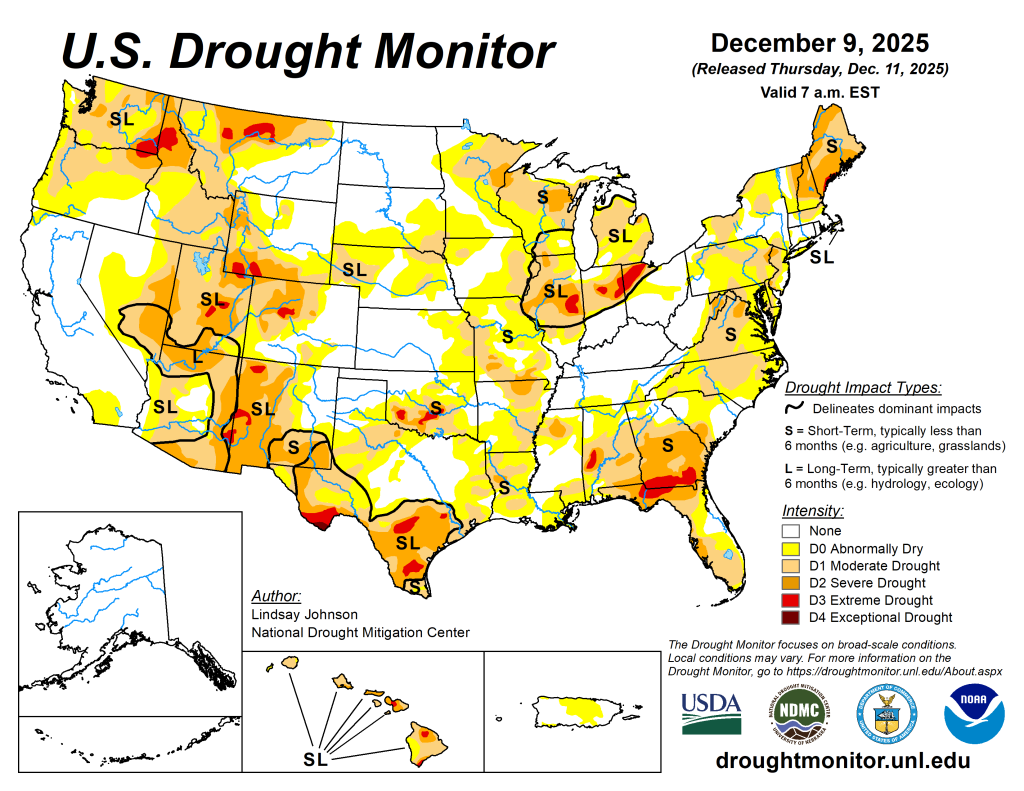- Uneven precipitation and colder weather finds the Plains

The latest U.S. Drought Monitor saw both improvements and degradations across the country, shaped largely by uneven precipitation and widespread colder-than-normal temperatures.
Much of the nation was colder than normal, with the sharpest departures in the Midwest and Northeast, where most of the week’s moisture fell as snow and offered limited short-term help for soils and streams. In the West, storm systems delivered substantial rain and mountain snow to the Pacific Northwest and northern Rockies, improving conditions in parts of Washington, northwest Oregon, western Montana and eastern Idaho.
However, areas that missed the heaviest precipitation—especially central and southern Oregon, central Idaho and southwestern Montana—saw drought expand as snowpack remained well below normal. Parts of the Southwest, including southeastern California and western Arizona, continued to improve as moisture from earlier storms worked through the hydrologic system, while east-central Nevada saw worsening drought due to very low snowpack and long-term precipitation deficits.
The central and southern Plains did not see any meaningful precipitation, leading to conditions remaining largely unchanged outside of localized areas. Short-term dryness worsened in southeastern Kansas and northeastern Oklahoma, where precipitation deficits continue to accumulate.
The U.S. Drought Monitor is jointly produced by the National Drought Mitigation Center at the University of Nebraska-Lincoln, the U.S. Department of Agriculture and the National Oceanic Atmospheric Administration. (Map courtesy of NDMC.)
South
The South saw mostly improvements following a mixture of below-normal temperatures and heavy rainfall. One-class improvements were seen from far eastern Texas to Mississippi where 1.5 to 3 inches of rain fell, with parts of southern Louisiana recording 5 to 6 inches of rain.
Areas of central Texas and the Panhandle that improved last week, continued to see improvements in soil moisture and streamflows, leading to further improvements. Isolated degradation did occur in Texas’ southwestern Panhandle as well in northeastern Oklahoma as lack of precipitation continues to stress soils and lead to lower streamflows.
Midwest
The Midwest had much colder-than-normal temperatures, and most of the week’s precipitation fell as snow, limiting its ability to improve soil moisture or streamflow. Drought changes in the Midwest were mixed and localized.
In Missouri, drought expanded slightly along the southern Missouri–Illinois border, including small areas shifting into moderate (D1) and severe (D2) drought, while the northwest part of the state saw abnormal dryness (D0) expand. At the same time, northeastern Missouri experienced improvements where short-term conditions recovered.
A small area along the central Missouri–Illinois border improved slightly.
High Plains
Conditions across the High Plains changed very little as much of the region received only light precipitation and remained colder than normal. The Dakotas saw little meaningful moisture, and Nebraska saw none, leaving drought conditions unchanged.
In Kansas, a lack of precipitation combined with continued short-term dryness led to an expansion of abnormal dryness (D0) that stretched into northeastern Oklahoma.
In eastern Wyoming, dryness increased where precipitation was limited, resulting in some expansion of abnormal dryness. In eastern Colorado, light snowfall helped ease small pockets of abnormal dryness, though most areas saw little change.
West
There was a mixture of improvements and degradations. Improvements were seen in the Southwest despite no precipitation. Prior weeks’ moisture has entered the hydrologic cycle, as seen in improving streamflows and soil moisture. Despite snow falling across the Rocky Mountains, many stations continue to report that the snow water equivalent is below the 30th percentile.
Snowpack levels in the northern Rockies are improved, with many stations showing snowpack at 100% for this time of year. A snowfall of 1 to 2 feet hit western Montana and eastern Idaho. This moisture led to improvement in northwest Montana. Improvements were also seen along the Idaho-Wyoming border where up to 2.5 feet of snow fell. Southwestern Montana and central Idaho, which are experiencing below-normal snowpack, missed out on the snow and saw an expansion of moderate drought (D1) across the border. Over the Pacific Northwest, storms brought up to 6 to 8 inches of precipitation, where many stations in the Cascades are reporting below snowpack below 50% of normal.
Looking ahead
According to the National Weather Service’s 5-day quantitative precipitation forecast (valid from Dec. 11 to 16), the heaviest precipitation is forecast across the Pacific Northwest, especially along the coastal ranges of Washington, Oregon, and far northern California. Moderate precipitation is also expected across the northern Rockies and into the northern Plains and Upper Midwest, with widespread amounts between 0.5 and 2 inches and localized areas of higher amounts where terrain enhances moisture, such as elevation and lake-effect snow.
Across the South and Southeast, a broad area of lighter but steady rain is anticipated from eastern Texas through the Gulf Coast states and into the Carolinas, generally ranging from 0.5 to 2 inches. In contrast, much of the Interior West—including the Great Basin, Southwest and central Rockies—shows little to no precipitation.
The Climate Prediction Center’s 6- to 10-day outlook (valid Dec. 16 to 20) favors widespread above-normal temperatures across most of the Lower 48, with the highest likelihood for above-normal temperatures centered over the Four Corners region and extending across the western and southern U.S.
Much of the Midwest, Great Lakes and Northeast were warmer than average, while only a small pocket of near-normal temperatures is suggested in parts of the northern Plains. Precipitation patterns show more divide with wetter-than-normal conditions favored across the Pacific Northwest, the northern Rockies and the Upper Midwest.
In contrast, drier-than-normal conditions are likely across the central and southern Rockies, the central Plains and much of the Southeast, with the strongest dry signal centered over Arizona, New Mexico and western Texas. Near-normal precipitation is expected across broad sections of the Midwest, Mid-Atlantic and Interior West.
Lindsay Johnson is with the National Drought Mitigation Center.
